Long Range Handgun
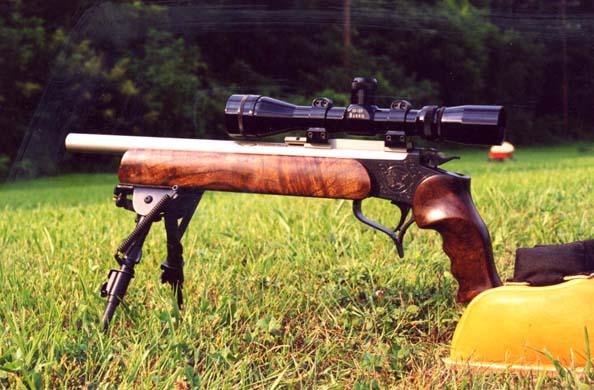
It all happened as a matter of circumstance. About a year ago, I was at the range with my Encore 15 .308, and there was a fellow at the bench next to me with a .223 Contender. After we talked for a bit, I offered to let him shoot the .308, which he did. I was shooting 168 grain bullets behind a stiff charge of Varget stiff recoil, too. He was impressed with the accuracy and balance of this Encore, but not so impressed with the trigger.
In turn, I got to shoot some clay discs (trap-shooter targets) with the Contender .223. He had placed them on the dirt of the backstop at a distance of about 105 yards. My first shot looked at first like a clean miss, but through the spotting scope I saw I had punched a clean .224 hole dead through the center of that disc. I cleanly dispatched a number of these clays without missing a single one.
I didnt know it at the time, but I had to have one of these Contenders. The most remarkable things about that gun were the low level of recoil, and the very nice trigger pull. The trigger was light, crisp, and clean as opposed to my heavy, lawyer-proof, Encore trigger (since reworked to a crisp 28 ounces by Fred Smith at Bullberry).
I didnt own a
Contender frame, but because of rumors (since substantiated
by T/C) that Contender production would soon be discontinued,
I felt that I needed to get one while they were still
available. I
was hampered a little by a new Maryland law that requires
all handguns to be accompanied by a fired shell casing
a little difficult with just a frame.
Virgin Valley Custom Gun found a frame that was
manufactured before 10/1/00 and thus was exempt from
the new law, so I bought it.
I had the frame sent to my FFL and was able to
retrieve it from him in about 4 weeks from time of purchase
(waiting period plus shipping time). My FFL, Rod Ellingsworth, an accomplished gunsmith, reduced
the trigger pull to the desired 1.5 lbs.
Later, Virgin Valley
Custom Guns offered me a deal I couldnt resist on a
.17 Remington barrel for my new frame.
The barrel is a stainless steel, matte finish,
15-inch bull barrel with a Virgin Valley scope base
installed with 6 screws.
I am still not sure why I need 6 screws to hold
the scope on this barrel, but I dont think that they
hurt anything.
The 10 twist on the barrel should be fine for
bullets up to 30 grains, and I intend to use mainly
25 grain bullets in this barrel.
I have printed
out a ballistic chart for my gun with the 25 grain Starke
bullets to show what it will do at extended ranges.
Since I am hoping to be able to take long shots
with this gun, I need to know how much it would drop
at the longer ranges.
Realistically, I want to be able to shoot ground
hogs to 200 250 yards with this gun.
I have a small copy of this chart that I can
tape to the fore end when going afield.
My chart was created using a free software program
called PointBlank, available from www.huntingnut.com. It is very useful and easy to operate not to mention free.
I ordered a Burris
3-12 EER for the project, but I just couldnt wait for
it to arrive, so I started out with a Burris 2-7 EER
scavenged from the Encore mentioned earlier.
Burris is the handgun scope as far as I am concerned.
When you are looking for a highpower handgun
scope, this is the only real option that you have, and
it is a good one.
The 3-12 power scope is great, the eye relief
is sufficient, and the field of view is excellent for
such a powerful scope.
I got the fine plex and the target knobs for
some serious long range shooting. The high magnification is almost imperative for shooting accurately
at long ranges with a handgun.
I got a nice target
style fore end 11 long, flat and about 2 wide for
use in the bags or use with the short Harris Bipod (Model
BR) I installed.
The grip and the fore end are both from Bullberry/Woodsmith.
They were inletted to fit perfectly and are fantastic
looking (See picture 1).
All of those Warmth
of Wood articles by Gary Ramberg must have gone to my
head because I came up with the bright idea that it
would be nice to finish the stock set myself.
I ordered both the fore end and the grip in a
semi-finished condition.
I thought it would be fun to finish them myself,
but after about 3 weeks of sanding and finishing decided
that it might be more fun to have them done.
I applied 6 coats
of Tru-oil finish to the stock with my finger, using
0000 steel wool between coats.
It looked good, but I was having trouble getting
all of the grain to fill. At this point, I was frustrated and turned for help yeah
I know its like stopping at a gas station to ask directions.
I turned to my favorite internet message board,
GoGoVarmintGo, explained my dilemma and got several
responders. I
learned from Claude Gatewood of Gatewood stocks that
I could use wet/dry sandpaper to apply the oil with
a sanding motion to fill the voids.
I did this and it worked perfectly.
I tried Arm-R-Seal in place of Tru-oil on the
fore end and am very happy with the results.
The grain was filled, and I achieved the rubbed
oil finish that I wanted.
I think I will enjoy the wood more knowing I
finished it myself, and I hope to finish a one-piece
stock in the future.
I experienced some
difficulties with my scope mount system.
The VVCG base seems to be undersized compared
to the Weaver base.
This requires the Burris zee rings to be tightened
excessively, and they loosened on two occasions under
the mild recoil of the .17.
As per the recommendation of Virgin Valley Custom
Gun, I tried the Warne rings and have experienced no
additional problems to date.
I actually like the Warne rings more than the
Burris, due to their ease of installation and removal.
I wish I could
tell you that I spent hundreds of hours trying 4 different
powders and 5 different bullets, but that just isnt
the case. I had every intention of trying a few different powders and
a couple of different bullets, but with the results
that I had with the first combination, I decided that
the time would be better spent looking for groundhogs
or working up loads for other guns.
The added bonus of the load that I settled on
was that it was the same load that my Remington model
700 prefers: 24.2 grains of IMR4320 behind a 25 grain
Starke RPVB.
The average velocity
of the preferred load was 3640 fps (pretty impressive
out of a stubby barrel handgun).
I found that the gun would shoot less than an
inch routinely and could shoot close to 5 shot groups
at 100 yards. (See pictures 2&3).
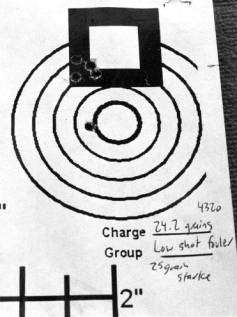
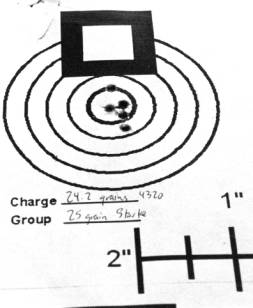
The range that
I usually shoot at only allows shooting out to 100 yards,
but I intend to set up a little range at my brothers
farm for some 200 yard shooting to see how it will do
at the extended range.
I want to be able to reach out to 200 yards when
hunting and to feel confident in this little gun.
According to the Pointblank software program
(www.huntingnut.com), if I am sighted for 100 yards,
the drop at 200 yards is 2 inches and at 300 yards is
9 inches. Seen
below is some information generated from Pointblank
software program for the hand loads.
Name:
.172 Cal, Starke HP, 25 grn
Ballistic
Coeff: 0.200
Bullet
Weight: 25
Velocity:
3650
Target
Distance: 100
Scope
Height: 1.500
Temperature:
70
Altitude:
500
Ballistic
Data
~~~~~~~~~~~~~~~
Range Elevation Velocity Energy ETA Drop
100
yds
0.00 in 3136 fps
546 fpe
0.089 sec
1.45 in
125
yds -0.14
in 3017 fps
505 fpe
0.113 sec
2.32 in
150
yds -0.51
in 2901 fps
467 fpe
0.138 sec
3.43 in
175
yds -1.14
in 2789 fps
432 fpe
0.165 sec
4.80 in
200
yds -2.06
in 2679
fps 398
fpe 0.192
sec
6.45 in
225
yds -3.28
in 2571 fps
367 fpe
0.221 sec
8.41 in
250
yds -4.82
in 2466 fps
338 fpe
0.251 sec
10.68 in
275
yds -6.70
in 2364 fps
310 fpe
0.282 sec
13.31 in
300
yds -9.00
in
2264 fps
285 fpe
0.314 sec
16.34 in
When time will
allow, I still plan on trying some Vihtavouri n135 that
I had gotten for this gun a while ago, just to see if
I can get the velocity up a little more.
During one of the
days of range testing, I had decided to shoot some Remington
factory-loaded rounds that I had in my safe collecting
dust. I
figured that I would test them for accuracy and velocity
with this gun to see how it compared to my reloads.
I got quite a surprise from both the chronograph
reading and the accuracy results on paper.
I figured that they would be fast stepping loads,
but the average velocity reading over the 10 shots was
only 3250 fps as compared to 3640 fps with the reloads
(See Pictures 4 & 5).
I was very surprised at the slower velocity of
the factory ammunition.
I would have been expecting 100 fps lower velocity
at the most.
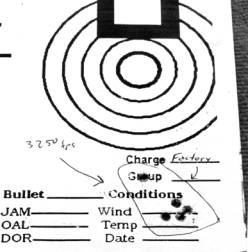
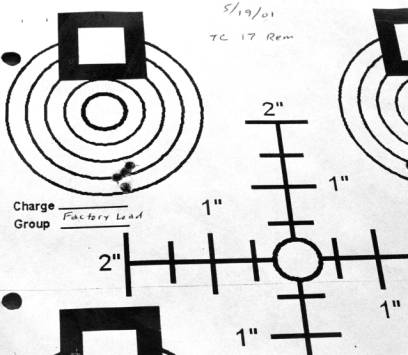
Now for the pleasant
surprise: both 5 shot groups measured less than an inch
much less than an inch!
One measured 0.89 and the other measured 0.36
out of a handgun no less! The POI was approximately 2 inches lower than the reloads I
had the gun sighted in for, but they still printed on
the paper. If
I needed to use factory ammo in this gun, the POI would
be 3 inches low at 200 yards and 12.5 inches low at
300 yards (assuming that I adjusted the scope so that
the POI at 100 yards was on target).
Seen below is a chart generated from Pointblank
software program for the factory loads.
Name:
.172 Cal, Hornady HP, 25 grn
Ballistic
Coeff: 0.200
Bullet
Weight: 25
Velocity:
3250
Target
Distance: 100
Scope
Height: 1.500
Temperature:
70
Altitude:
500
Ballistic
Data
~~~~~~~~~~~~~~~
Range Elevation
Velocity
Energy
ETA
Drop
0 yds
-1.50 in
3250 fps
586 fpe
0.000 sec
0.00 in
25
yds -0.77
in
3128 fps
543 fpe
0.024 sec
0.11 in
50
yds -0.27
in
3009 fps
503 fpe
0.048 sec
0.43 in
75
yds -0.00
in
2893 fps
465 fpe
0.073 sec
1.00 in
100
yds
0.00 in
2781 fps
429 fpe
0.100 sec
1.83 in
125
yds -0.28
in
2671 fps
396 fpe
0.127 sec
2.94 in
150
yds -0.86
in
2564 fps
365 fpe
0.156 sec
4.35 in
175
yds -1.77
in
2459 fps
336 fpe
0.186 sec
6.09 in
200
yds -3.03
in
2357 fps
308 fpe
0.217 sec
8.18 in
250
yds -6.80
in
2160 fps
259 fpe
0.284 sec
13.62 in
300
yds -12.41
in 1972
fps 216
fpe 0.356
sec 20.89
in
While looking at
the groups shot, I noticed a large number of shots were
outside of the group.
I was first attributing these flyers to a bad
load or even from being the first shot from a clean
barrel. What
I found was that the first shot was a little lower in
velocity, but usually only by 30 50 fps, which wouldnt
account for the vertical dispersion that I was experiencing.
After determining that the velocity wasnt the
cause of the vertical dispersion, I was unsure what
might be causing the problem.
I think that the vertical dispersion is occurring
from my gun handling technique while shooting the handgun
from a bench.
I have been using the bi-pod and then resting
the grip of the gun on the edge of a rear sand bag.
I would press the grip into the bag to ensure
a solid hold on the target (See picture 6 below).
This technique was very effective at keeping
the gun still during the trigger squeeze but was not
allowing the gun to recoil consistently.
I will need to do some further testing with a
different method of holding the gun to prove this theory,
but I think that the gun handling is to blame for the
vertical dispersion in the groups shown.
Every group fired has more vertical dispersion
than horizontal which is odd for any gun much less
a .17. I
would like to shoot this gun using a flat rear bag that
can allow the gun to recoil consistently.
I may also try using a front rest in place of
the bi-pod to see if that reduces the vertical dispersion.
If all else fails, I may resort to shooting 3
shot groups (Sarcasm noted).
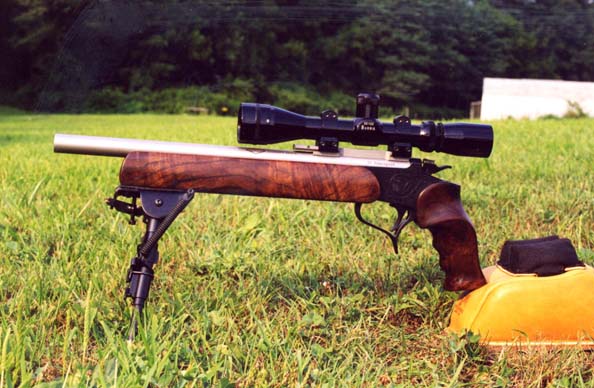
I hope to use this
handgun for ground hog shooting out to 200 yards.
For any shots further than that, I will switch
to one of my longer-barreled .17s until Ive had more
long-range practice with the handgun.
This project would
be a great choice for somebody just starting to get
into reloading or somebody with an interest in varmint
hunting with a handgun.
It is also nice to be able to shoot factory ammo
in a pinch. It
is easy to shoot, the recoil is low and the enjoyment
is significant.













